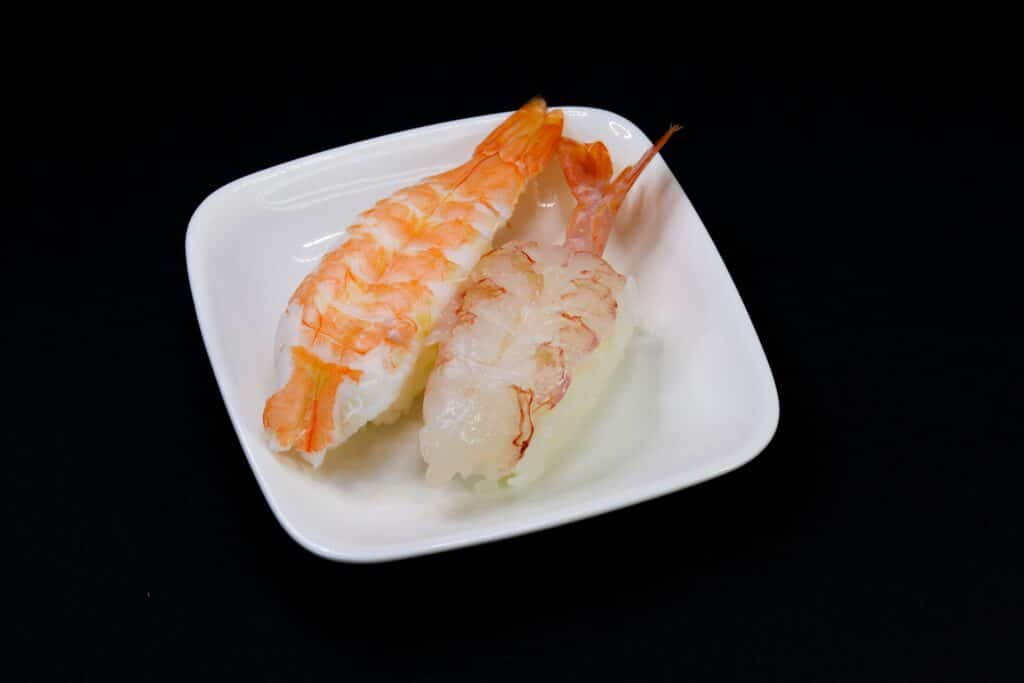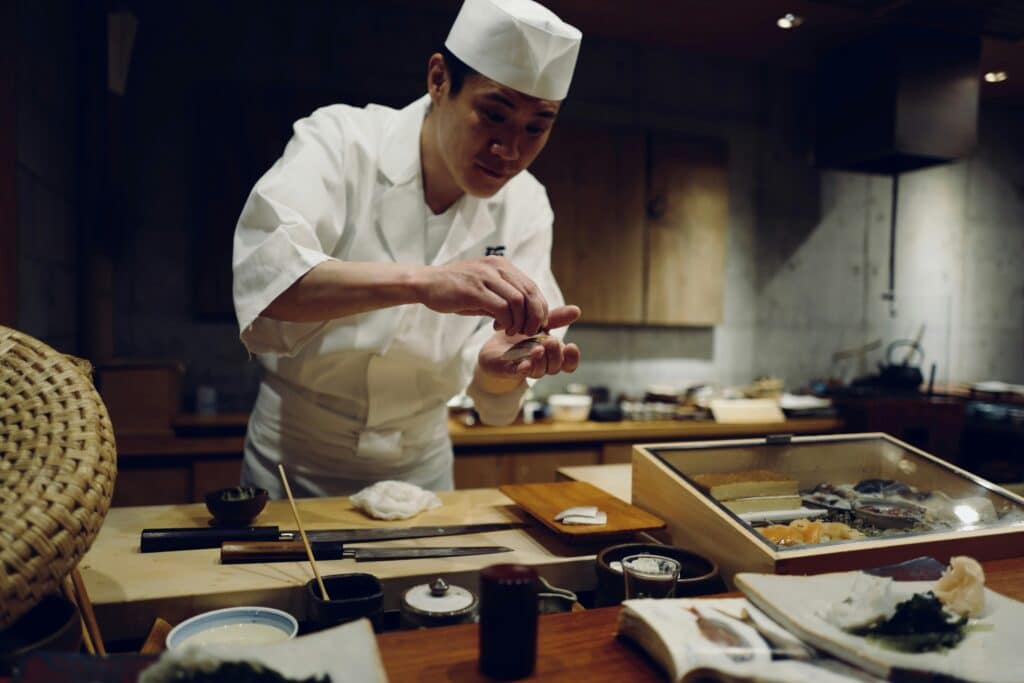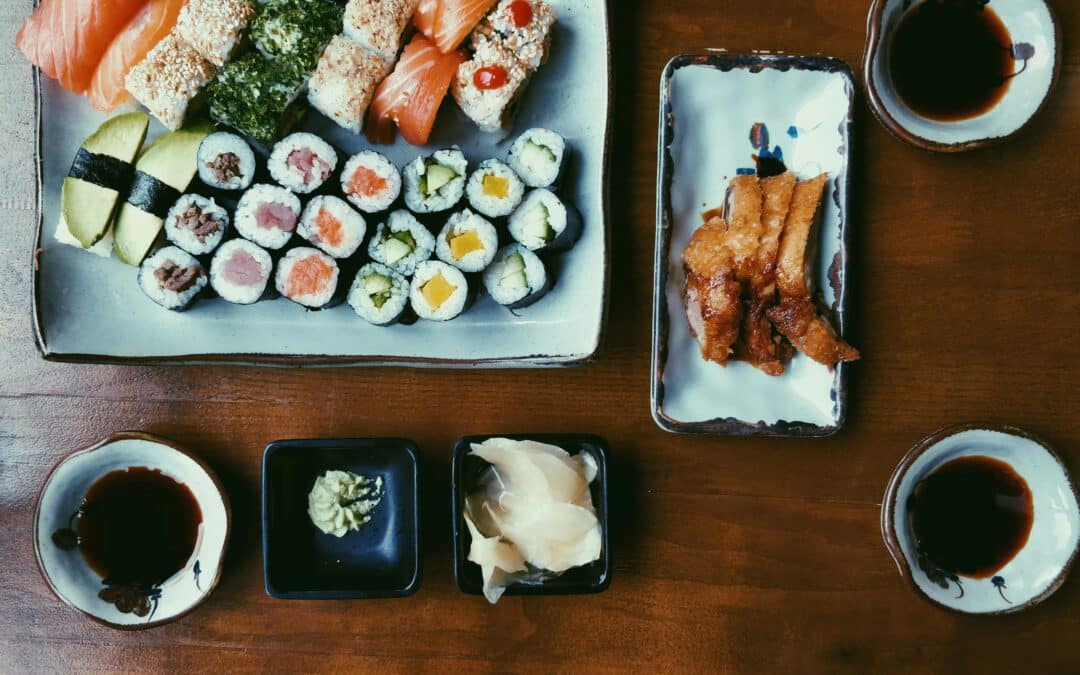Often regarded as one of the most fascinating and distinctive eating experiences, nyotaimori combines the fine artistry of sushi with a novel presentation technique. This age-old Japanese custom, literally translating to “the art of serving sushi on a human body,” immerses guests in a realm where human art form and culinary prowess coexist. Though it may cause some people to scoff at first, Nyotaimori has deep cultural and historical value and provides an insight into the depths of Japanese cuisine and the extent to which it can captivate and stimulate the senses.
By dissecting this intriguing custom, we can see that nyotaimori is a celebration of shape, beauty, and the fleeting aspect of culinary art rather than merely consuming sushi from a live person. Despite having its origins in Japan, this method has spread around the world, changing and adapting to fit the needs of various audiences and cultures. It still exists today as a tribute to the intricate customs of Japanese cooking as well as a modern example of inventive cooking techniques and visually stunning plating.

The Origins of Nyotaimori
The tradition of nyotaimori, which translates to “female body presentation,” has its origins in the rich cultural fabric of Japan, where the interaction of the human form, food, and art has a long history that is as fascinating as the practice itself. Serving sushi or sashimi on a human body—usually a woman’s—is a traditional Japanese art form that represents more than simply display; it also represents trust, respect, and the desire for aesthetic harmony between human workmanship and nature.
The history of Nyotaimori is a little obscure, having its roots in the Edo era records of Japan. It is thought to have originated as an opulent kind of entertainment for samurai, a class of people renowned for their appreciation of all forms of art, including culinary skills. In these early cases, nyotaimori was more than just food; it was entwined with the samurai ethos, which celebrated strength, beauty, and the fleeting aspect of life.
Nyotaimori changed along with Japan as it went through the Meiji Restoration and into the contemporary age. From a samurai extravagance, this became a wider cultural manifestation, yet it stayed on the periphery of traditional Japanese eating practices. More recently, the method has come back into vogue, being known outside of Japan as a unique and often contentious kind of cooking.
The modern version of Nyotaimori combines the traditional Japanese reverence for food presentation with a contemporary interest in distinctive and immersive eating experiences. These days, Nyotaimori gatherings are painstakingly organized, highlighting the creative presentation of sushi and sashimi while guaranteeing the model’s comfort and dignity. This contemporary version navigates the sensitivities and ethical issues of a worldwide audience while paying tribute to its historical roots.
Nyotaimori’s transition from medieval banquets to contemporary dining rooms has drawn praise and criticism. However, its persistence and development point to a basic human predisposition to appreciate art in all its manifestations. Nyotaimori is a living example of the intricacies and beauty of cultural traditions that endure over time, captivating, challenging, and enchanting people for generations to come.

The Art and Etiquette of Nyotaimori
Nyotaimori, a method that combines culinary competence with the art of presentation, is frequently viewed through a lens of wonder and fascination. Sushi production is an artistic endeavor, and the model who serves as the human plate has been treated with great care and respect, as seen by the painstaking preparations made for this special eating experience. This methodical procedure demonstrates a commitment to cleanliness, beauty, and respect for one another—elements that form the basis of the discipline.
The Preparation of Nyotaimori
The model goes through a rigorous grooming procedure in advance of the event to make sure that her skin is perfectly clean and devoid of any lotions or perfumes that can overpower the aroma and flavor of the sushi. Models are frequently trained to remain still for prolonged periods of time, all the while keeping a poise that honors the solemnity and concentration demanded by both chefs and diners. The sushi is made by talented chefs who use the freshest ingredients to create visually appealing and delectable pieces. Sushi is arranged on the model as a creative exercise; each piece is thoughtfully positioned to produce a visually pleasing arrangement that also takes the figure’s comfort and dignity into consideration.
The Etiquette of Eating Sushi off a Person
To participate in Nyotaimori, one must comprehend and value the customs and protocol that guide this activity. The ideas of professionalism and consent are crucial to this. Models understand the artistic and gastronomic context of their involvement and give their agreement to be part of the event. In return, patrons are supposed to treat the models with dignity and respect, viewing them as essential components of the art form rather than as objects. This entails refraining from offensive remarks, gestures, or behaviors that might diminish the experience’s dignity.
Chefs, models, and diners all follow a code of behavior that guarantees the event stays dignified, courteous, and centered around the celebration of culinary art. Professionalism is crucial. Etiquette is also very important; customers are usually instructed on how to choose sushi so as to limit the model’s pain; this usually involves using chopsticks and avoiding direct touch. By doing this, the experience’s integrity is preserved and it doesn’t become an objectification of art or culinary prowess.
Experiencing Nyotaimori Today
Nyotaimori, which is frequently viewed through an enigmatic and mysterious veil, has made its way beyond its Japanese origins to captivate and enthrall diners worldwide. It has become a part of the global culinary traditions. These days, this distinctive art form is served at high-end events and restaurants far beyond of Japan, adjusting to a variety of cultural settings but keeping the essential components that make it so alluring.
Global Adoption and Adaptation
Nyotaimori has expanded into new areas and been praised while also being developed to accommodate a global audience’s wide range of preferences. It is positioned in some places as the height of opulent dining experiences, a marriage of tradition, art, and cuisine that ensures a night to remember. In other places, Nyotaimori is welcomed as part of cultural displays or themed events, providing an insight into the intricate customs and procedures of Japanese cuisine. Along the way, Nyotaimori has expanded its worldwide reach and created innovative versions that represent the unique flavors and aesthetics of each place. These differences range from the types of cuisine offered to the presentation techniques.
The Diner’s Experience
Attending a Nyotaimori gathering is more than just eating for the attendees. It’s an immersive experience into a world where art and cuisine collide, where each expertly prepared and arranged piece of sushi begs to be admired before being consumed. The initial astonishment and fascination frequently give way to a deeper comprehension of the careful preparation and reverence for the food as well as the human canvas. The combination of a personal and public dining environment heightens one’s senses, allowing one to appreciate the sushi’s flavor, scent, and presentation all over again.
The Model’s Perspective
In Nyotaimori, the model plays a crucial role and necessitates a high level of discipline and professionalism. Models who provide their bodies as a conduit between the culinary and visual arts frequently characterize the experience as one of strength and vulnerability. Extensive preparation ahead of time guarantees that models are psychologically and physically acclimated to the calm and revered ambiance of Nyotaimori. Their presence at the event contributes to the overall visual and sensory experience by embodying the serenity and elegance required by the art. The model views it as a test of her artistic expression and her ability to set boundaries while adhering to a custom that values her body as an integral component of the dining table.
A Sensory and Artistic Journey
Be it as a diner or a model, taking part in a Nyotaimori event means immersing yourself in a custom that questions established eating conventions and encourages reflection on beauty, art, and the fleeting nature of culinary creations. Respect for the food, the human form, and the cultural legacy it originates from are all required by this discipline. Nyotaimori is a monument to the timeless attraction of fusing creative innovation with fine cuisine as it continues to grow and adapt in different regions of the world.
Fundamentally, nyotaimori is a deferential celebration of the elaborate beauty of Japanese culinary customs, a medium on which food is transformed into an artistic and sensual experience. Diners’ deliberate participation, the model’s careful preparation, and the sushi’s artistic presentation all combine to create an eating experience that is private and shared, personal and communal. It invites diners to reevaluate their ideas of beauty, enjoyment, and temporality within the setting of a meal, challenging established eating conventions in the process.
As nyotaimori develops and adapts to other cultural situations outside of Japan, it keeps its core values intact by stressing the value of professionalism, respect, and permission from all parties involved. Environments that respect the human form, the artistry of sushi production, and the deep relationships that food can make between people are conducive to the practice’s success. By doing this, nyotaimori celebrates the delight of shared culinary experiences and bridges the gap between the past and present by providing a window into the richness of Japanese culture.
The evolution of nyotaimori from its historical roots to its modern adaptations highlights the timeless allure of blending inventive cooking with beautiful art. Yotaimori, with its appreciation for its cultural origins and its acceptance of the multiplicity of its contemporary manifestations, is a living example of how customs may be revived and maintained in an increasingly interconnected world. No matter where we encounter it—in the calm surroundings of a traditional Japanese inn or on the busy streets of Las Vegas—nyotaimori urges us to discover the diverse range of human ingenuity and the limitless opportunities that present themselves when we dare to combine the realms of art and cuisine.



Recent Comments